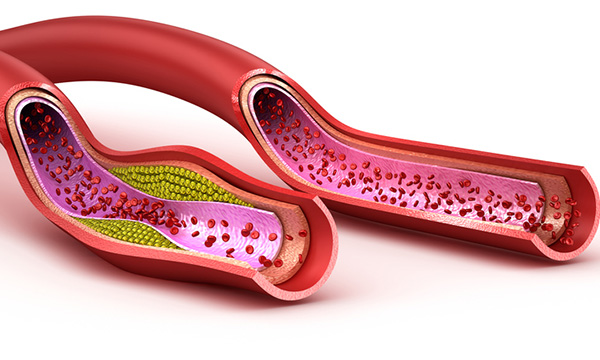
ARUP Laboratories will now have faster turnaround time on particle-cholesterol testing, having recently moved its test in-house. Shown is an image of a blood vessel damaged by bad cholesterol.
Heart disease ran in Richard’s family and now, at 34 and heavier than he should be, he was being tested for particle (or lipid) cholesterol, a nontraditional test for heart health. This is a bit unusual; patients are more commonly measured for two main factors: low-density lipoprotein (LDL) and high-density lipoprotein (HDL). Those are bad and good cholesterol, respectively.
Why does anyone move beyond the standard cholesterol tests to measure particles? Lipid testing is sometimes recommended (such as by the National Lipid Association, or NLA) for people who have risk factors, including family history and weight gain at an early age. Those tiny bits, the particles, could more ably slip through openings between cells lining the arteries—and could trigger a heart attack or stroke.

David Grenache, PhD, is medical director in the chemistry division at ARUP Laboratories and oversees the new particle-cholesterol test, LipoFIT.
Special factors usually bring a person to take the test. For instance, if someone has a strong history of cardiovascular disease (CVD) and they get normal results to regular cholesterol measurements—but they’re still concerned, they might opt for a nontraditional screening, explains John J. Ryan, MD, at the University of Utah Division of Cardiovascular Medicine. In other cases, a person may receive a high-cholesterol reading and opt to take a nontraditional test to better assess risk over the next five years.
That said, lipid screens and other nontraditional tests for cholesterol health should only be ordered for specific reasons—including the risk factors mentioned by the NLA. “There is a wide body of evidence that the LDL particle count provided by this test is a stronger risk indicator than LDL cholesterol. So that’s probably a compelling reason why people order the test, “ says David Grenache, PhD, medical director in the chemistry division at ARUP Laboratories.
ARUP Laboratories will now have faster turnaround time on particle-cholesterol testing, having recently moved its test in-house. That test, LipoFIT, will use a new, in-house design called the Data Matrix Scanner to run large batches of specimens. Technicians wanted a machine to capture images of multiple 5mm-wide codes, record the data in software, and keep it for later reconciliation at the end of several steps. Ultimately, the system includes a camera, LED light bars, and a miniature computer that allows the lab to scan codes and see results. “All of that is enclosed in an instrument that was designed, built, and tested by the automation team at ARUP,” says Joseph Seegmiller, mechanical engineer of Automation Projects at ARUP.
“This machine is very exciting–we decided how to bring a lab in-house and our engineers took those technical needs and designed a solution. It’s going to streamline our work,” says Thomas Jung, lead medical technologist at ARUP, who worked with technical supervisor Theresa Kunzler (also in the Electro/Manual Endo lab) and in-house engineers to plan Data Matrix.
John J. Ryan, MD“If someone has a strong history of cardiovascular disease and they get normal results to regular cholesterol measurements, but they’re still concerned, they might opt for a nontraditional screening.”
University of Utah Division of Cardiovascular Medicine
Now the test will speed along at ARUP. Grenache adds, “It’s exciting to bring the test back, and to be able to offer it to clients again directly at ARUP.”
Now people like Richard, and his physician, can get lab results fast when it comes to zeroing in on the health of his heart.
Catherine Arnold, Science Communications Writer
















